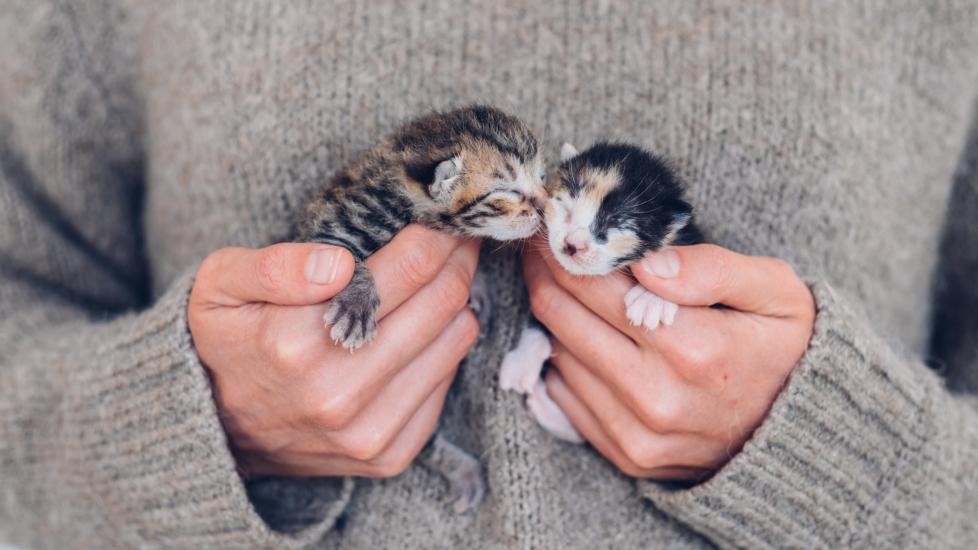When Do Kittens Open Their Eyes?
MiMaLeFi/iStock / Getty Images Plus via Getty Images
A cat’s eyes are one of the most fascinating parts of his body. Although cats are more nearsighted than humans—needing to be 10 times as close to an object to see it as clearly as we do—they have better vision in low lighting and a wider field of view.
However, they are not born possessing these features. Newborn kittens’ eyes open and develop fully over the first months of their lives. As such, a kitten’s early life is a time to prioritize eye care so his vision can develop properly and his eye health can be maintained throughout his life.
When Do Kittens Open Their Eyes?
A kitten’s eyes are typically fully open by about 10–14 days of age.
Like many other predator species, kittens are born with their eyes closed. This helps prevent infection and damage to the eyes during the birthing process.
During birth, kittens leave the sterile environment of the womb and enter the outside world, where numerous types of bacteria and viruses exist. These may infect kittens during a time when their immune system is naive (meaning it has not yet been exposed to disease-causing agents). In addition, tear production takes a few weeks to begin in newborn kittens, so closed eyelids help keep the surface of the eyes moist.
Over the next couple of weeks, a kitten’s eyes typically begin to open. They should be fully open by the time the kitten is 2 weeks old. In most cases, both of a kitten’s eyes will open at the same time, but it’s possible for the left and right eyes to open separately.
Once a kitten’s eyes are open, it can take another few months for his vision to develop fully.
When Do Kittens’ Eyes Change Color?
Most kittens are born with blue eyes. This is because the cells in their eyes that produce melanin (a type of pigment) are not very active for the first six weeks of a kitten’s life. Lack of pigment makes the two layers of the iris (the colored portion of the eye) appear blue.
Over the first couple of months of life, these pigment cells will begin to produce melanin, a dark pigment that affects the kitten’s mature eye color as an adult. While some adult cats will retain the blue eye color they had as a kitten, most adult cats will have eyes in various shades of yellow, green, orange, or brown.
Common Eye Problems in Kittens
Unfortunately, kittens can develop several eye problems. These include:
-
Microphthalmia: a condition where a kitten is born with a smaller-than-normal eye
-
Coloboma: a condition in which the eyelids do not fully develop
-
Entropion: when a kitten’s eyelids are turned inward
-
Prolapsed third eyelid: the third eyelid slips from its normal position and bulges outward in the corner of the eye
-
Conjunctivitis (pink eye): inflammation from viruses and bacteria like feline herpesvirus, Chlamydophila, and feline calicivirus
-
Cysts in the front chamber of the eye
-
Improper formation of the lens or retina, which can affect vision
If your kitten’s eyes are very red, if he’s squinting a lot or pawing at them, if there’s a lot of discolored discharge, if he seems less interested in food or water, or if his energy is much lower than normal, seek veterinary care as soon as possible. It’s important to have all eye issues addressed promptly to preserve the health of your kitten’s eyes.
How to Care for a Kitten’s Eyes
Although kittens can be predisposed to several different eye conditions, proper cleaning of the eyes and monitoring of eye health at home can go a long way toward keeping a kitten healthy.
Use a gentle, kitten-appropriate eye cleaner as needed. Good examples are Vetericyn® Plus Antimicrobial Eye Wash and Miracle® Care Sterile Eye Wash Pads. Kittens should not need to have their eyes cleaned unless you notice debris in their eyes. Consult with your primary veterinarian about which product is best for your kitten’s eyes and how often the product should be used.
Another important factor in a kitten’s eye health is proper nutrition. Many kitten food formulas contain higher levels of DHA than adult cat foods. DHA is an omega-3 fatty acid required for proper brain and eye development in kittens.
A good example of a kitten diet that contains an appropriate level of DHA is Purina® Pro Plan® Kitten Shredded Blend Chicken & Rice Formula Dry Cat Food, but any kitten diet from the major pet food brands such as Purina®, Hill’s®, Royal Canin®/MD, and Iams™ will have enough DHA in it to support eye health in growing cats.
References
Large T, Blacklock B. Ophthalmologial conditions in kittens and young cats. Royal Canin Vet Focus. May 2019;29(1).
